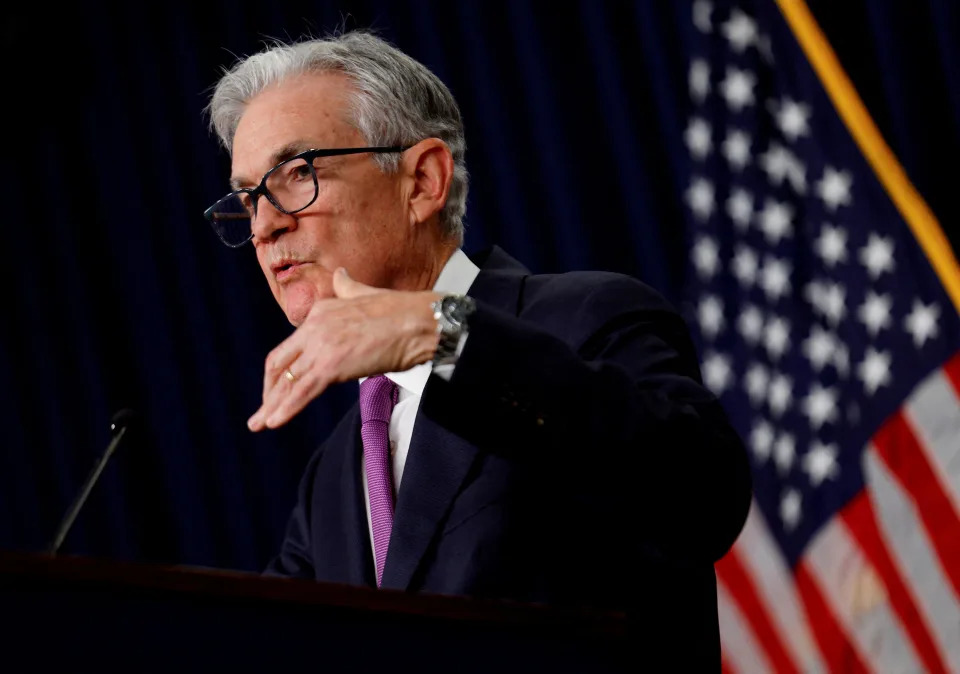The Federal Reserve slashed interest rates by a half percentage point Wednesday and charted a course for two additional cuts this year followed by four more in 2025.
The action marks the Fed’s first easing of monetary policy since 2020 and the termination of its most aggressive inflation-fighting campaign since the 1980s.
The decision came in a split vote at the conclusion of the Fed’s two-day policy meeting as officials cut the central bank’s benchmark rate by 50 basis points to a new range of 4.75%-5.0%.
Rates had previously been held at a 23-year high since last July.

U.S. Federal Reserve Chairman Jerome Powell. REUTERS/Evelyn Hockstein · (REUTERS / Reuters)
There was some division on the final decision, with Fed Governor Michelle Bowman dissenting.
She preferred to cut rates by 25 basis points instead of 50. No Fed official has voted against a policy decision in two years, matching one of the longest such streaks in the past half century.
Moreover, no Fed governor has dissented on a rate decision since 2005.
The consensus among Fed officials at today’s meeting was that they now see two more 25 basis points of future cuts this year, followed by four more cuts next year and two more cuts in 2026.
Nine officials saw 4 cuts this year, seven saw three cuts, 2 officials saw two cuts this year and one saw 5 cuts this year.
When considering additional rate cuts, the Fed said it will assess incoming data, the evolving outlook and the balance of risks.
Officials made their decision today because they are increasingly concerned about a slowing labor market and have gained confidence inflation is likely heading back down to their 2% target.
Employment decelerated over the summer with 118,000 jobs created in June, 89,000 created in July and 142,000 in August – all below the average monthly gain of 202,000 over the prior 12 months.
Some Fed officials thought a cut could have been made at the central bank’s last meeting in July, according to minutes from that meeting.
Fed Chair Jay Powell said in his last speech in Jackson Hole, Wyoming in late August that the Fed “will do everything we can to support a strong labor market as we make further progress toward price stability.”
He noted that the Fed does not "seek or welcome further cooling in labor market conditions" and that the current level of the policy rate gives the Fed “ample room” to lower rates in response to any weakening in the job market.
Another big reason for the cut today is the increasing confidence Fed officials have about the direction of inflation. That confidence was reinforced by five consecutive reports from the the Consumer Price Index that showed progress after some hotter-than-expected readings in the first quarter.
Officials said in their statement that inflation has made “further progress” instead of “some further progress” towards the Fed’s 2% goal, but still remains somewhat elevated.
“The Committee has gained greater confidence that inflation is moving sustainably toward 2% and judges that the risks to achieving its employment and inflation goals are roughly in balance,” the policy statement read.
Officials see the unemployment rate ending the year at 4.4%, up from previous level of 4.0% while economic growh is seen growing at 2% instead of 2.1% for this year and holding that 2% level the next two years.
The outlook for interest rate projections comes as Fed officials now see the unemployment rate ticking up to 4.4% from its previous forecast of 4.0%. Inflation is seen ending the year at 2.6% and the economy is seen growing at 2% instead of 2.1% for this year and holding that 2% level the next two years.
Meanwhile inflation is seen ending the year at 2.6% and 2.2% next year.
The action marks the Fed’s first easing of monetary policy since 2020 and the termination of its most aggressive inflation-fighting campaign since the 1980s.
The decision came in a split vote at the conclusion of the Fed’s two-day policy meeting as officials cut the central bank’s benchmark rate by 50 basis points to a new range of 4.75%-5.0%.
Rates had previously been held at a 23-year high since last July.
U.S. Federal Reserve Chairman Jerome Powell. REUTERS/Evelyn Hockstein · (REUTERS / Reuters)
There was some division on the final decision, with Fed Governor Michelle Bowman dissenting.
She preferred to cut rates by 25 basis points instead of 50. No Fed official has voted against a policy decision in two years, matching one of the longest such streaks in the past half century.
Moreover, no Fed governor has dissented on a rate decision since 2005.
The consensus among Fed officials at today’s meeting was that they now see two more 25 basis points of future cuts this year, followed by four more cuts next year and two more cuts in 2026.
Nine officials saw 4 cuts this year, seven saw three cuts, 2 officials saw two cuts this year and one saw 5 cuts this year.
When considering additional rate cuts, the Fed said it will assess incoming data, the evolving outlook and the balance of risks.
Officials made their decision today because they are increasingly concerned about a slowing labor market and have gained confidence inflation is likely heading back down to their 2% target.
Employment decelerated over the summer with 118,000 jobs created in June, 89,000 created in July and 142,000 in August – all below the average monthly gain of 202,000 over the prior 12 months.
Some Fed officials thought a cut could have been made at the central bank’s last meeting in July, according to minutes from that meeting.
Fed Chair Jay Powell said in his last speech in Jackson Hole, Wyoming in late August that the Fed “will do everything we can to support a strong labor market as we make further progress toward price stability.”
He noted that the Fed does not "seek or welcome further cooling in labor market conditions" and that the current level of the policy rate gives the Fed “ample room” to lower rates in response to any weakening in the job market.
Another big reason for the cut today is the increasing confidence Fed officials have about the direction of inflation. That confidence was reinforced by five consecutive reports from the the Consumer Price Index that showed progress after some hotter-than-expected readings in the first quarter.
Officials said in their statement that inflation has made “further progress” instead of “some further progress” towards the Fed’s 2% goal, but still remains somewhat elevated.
“The Committee has gained greater confidence that inflation is moving sustainably toward 2% and judges that the risks to achieving its employment and inflation goals are roughly in balance,” the policy statement read.
Officials see the unemployment rate ending the year at 4.4%, up from previous level of 4.0% while economic growh is seen growing at 2% instead of 2.1% for this year and holding that 2% level the next two years.
The outlook for interest rate projections comes as Fed officials now see the unemployment rate ticking up to 4.4% from its previous forecast of 4.0%. Inflation is seen ending the year at 2.6% and the economy is seen growing at 2% instead of 2.1% for this year and holding that 2% level the next two years.
Meanwhile inflation is seen ending the year at 2.6% and 2.2% next year.









 פוסטים אחרונים בבלוג
פוסטים אחרונים בבלוג

 הודעות חשובות
הודעות חשובות
ערב טוב. תחום בעייתי כי כל הפוקוס הולך ל2-3...
ערב טוב.
שחקן מעוף אתמול, 23:00תחום בעייתי כי כל הפוקוס הולך ל2-3 הגודלות ומסיבה מאוד הגיונית הנוגעת בין היתר להיקף המזומנים ופוטנציאל הרכישה.
זו חברה שלא השכילה לנצל את המצב, היקפי שורט עצומים (ובצדק) ובאופן כללי מגמת...